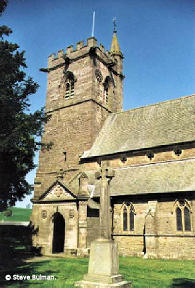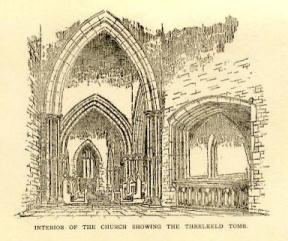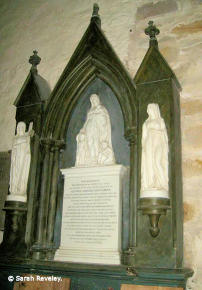CROSBY CHURCH. Its Architecture, &c.
 The
architecture of the Church may be best understood from the foregoing
illustrations, which require little or no description. The Church was
built after the usual cruciform plan, having a nave, chancel, transept,
side aisles and tower. The first historic record concerning it is in the
year 1140, when it was granted to Whitby Abbey. Previous to this time
(if it existed) it would merely be a wooden structure, which would then
be replaced by a stone one built after the later Norman style or
architecture. Part of this original structure is still to be seen in the
massive piers supporting the transept arches. Then again in the early
part of the thirteenth century it has been partly pulled down and
rebuilt in the early English style. Of this character are the columns
and arches of the name. Similar arches have also been erected upon the
old piers in the transept. The change is very marked in one instance,
where the arch is brought down and placed upon one of the old low
columns, considerably to one side of the capital. At that time the
Church would assume the character which it still in general retains. The
richly moulded doorway belongs to this period, and also some of the
windows, removed when last rebuilt, one of which is in the Churchyard
wall. Towards the end of the same century the Decorated Style was
introduced, to which the two north windows may be considered to
belong. The next style introduced was the Perpendicular, which prevailed
in the fifteenth century till near the Reformation. To this belongs the
east window, which, from being badly proportioned and not in character
with the rest of the architecture is somewhat objectionable. To about
the same period also belongs the architecture of the Threlkeld Arch and
Chapel. The steeple window is another specimen of this style, of a
later period. There is a traditionary record that his tower was built
about the same time as that of Shap Abbey, some time in the latter part
of the reign of Henry VI.
The
architecture of the Church may be best understood from the foregoing
illustrations, which require little or no description. The Church was
built after the usual cruciform plan, having a nave, chancel, transept,
side aisles and tower. The first historic record concerning it is in the
year 1140, when it was granted to Whitby Abbey. Previous to this time
(if it existed) it would merely be a wooden structure, which would then
be replaced by a stone one built after the later Norman style or
architecture. Part of this original structure is still to be seen in the
massive piers supporting the transept arches. Then again in the early
part of the thirteenth century it has been partly pulled down and
rebuilt in the early English style. Of this character are the columns
and arches of the name. Similar arches have also been erected upon the
old piers in the transept. The change is very marked in one instance,
where the arch is brought down and placed upon one of the old low
columns, considerably to one side of the capital. At that time the
Church would assume the character which it still in general retains. The
richly moulded doorway belongs to this period, and also some of the
windows, removed when last rebuilt, one of which is in the Churchyard
wall. Towards the end of the same century the Decorated Style was
introduced, to which the two north windows may be considered to
belong. The next style introduced was the Perpendicular, which prevailed
in the fifteenth century till near the Reformation. To this belongs the
east window, which, from being badly proportioned and not in character
with the rest of the architecture is somewhat objectionable. To about
the same period also belongs the architecture of the Threlkeld Arch and
Chapel. The steeple window is another specimen of this style, of a
later period. There is a traditionary record that his tower was built
about the same time as that of Shap Abbey, some time in the latter part
of the reign of Henry VI.
The next most important change in its architectural history was in 1811. In this and the following year it was in a great measure rebuilt. The roof of the old church was leaded, and where the present new chancel Arch is, near to the roof, were twelve small round-headed windows, representing numerically the twelve apostles; these were entirely removed. Most of the other windows were also taken out and replaced by the present ones, which are of a character that deservedly comes under the style The Debased. At this time the embattlements were removed from the tower, and some elaborate work introduced surmounted by pinnacles ornamented with crotchet work; many of the buttresses are also surmounted by similar ones. The porch and chancel doorway were ornamented with elaborately carved work, which though highly creditable to those engaged in the good work of remodelling the sacred edifice, are far from being in accordance with ecclesiastical architecture of the present day. The interior sittings, pulpit, &c., were refitted at the same time, and the interior decorated with texts from Scripture, scroll work, &c., chiefly done by George Gibson, Esq.
Another change in its history took place about 1849, when G.F. Weston was instituted vicar. He began by having the whitewash and plaster removed from all the columns and arches, which were re-hewn. At the expense of himself and friends he built the lofty chancel arch in place of what was before but temporary woodwork, and another arch between the north transept and the small chapel belonging to Crosby Hall. The sittings were rearranged and the handsome seats introduced in the choir. By the voluntary contribution of landowners, residents, &c., the money was raised for erecting a vestry and heating the Church by the circulation of hot water; at which time the body of the Church was somewhat lowered, while the chancel was raised to its proper proportions. Previous to rebuilding in 1811, it was entered by a descent of three or four steps, and was then filled up.
 The next objects demanding attention are the
monuments. The oldest of these are the Threlkeld tomb and a small
incised slab bearing the Hastings arms before noticed. These are in the
small side chapel. There is also another, lately removed from the
Churchyard into it, having an inscription of a Puritanical character;
and from the half obliterated letters it has been to the memory of Ann
Wharton, probably one of that family resident at Reagill Grange. Long
ago a number of throughstones stood in front of the Church; but these
were removed when in was rebuilt, and the stones used as flags, which,
with their half obliterated inscriptions, may be seen in different parts
of the Church. On one near the doorway may be seen an hour-glass and on
another a small cross, and several others of individuals, who, although
their names may be still engraven on stone, are themselves quite forgot.
The next objects demanding attention are the
monuments. The oldest of these are the Threlkeld tomb and a small
incised slab bearing the Hastings arms before noticed. These are in the
small side chapel. There is also another, lately removed from the
Churchyard into it, having an inscription of a Puritanical character;
and from the half obliterated letters it has been to the memory of Ann
Wharton, probably one of that family resident at Reagill Grange. Long
ago a number of throughstones stood in front of the Church; but these
were removed when in was rebuilt, and the stones used as flags, which,
with their half obliterated inscriptions, may be seen in different parts
of the Church. On one near the doorway may be seen an hour-glass and on
another a small cross, and several others of individuals, who, although
their names may be still engraven on stone, are themselves quite forgot.
 Of modern monuments there is a large one in the south
transept to the memory of George Gibson, Esq., erected by public
subscription. It displays a good deal of artistic taste, having affixed
to it three pieces of sculpture in marble, representing the figures of
Faith, Hope and Charity.
Of modern monuments there is a large one in the south
transept to the memory of George Gibson, Esq., erected by public
subscription. It displays a good deal of artistic taste, having affixed
to it three pieces of sculpture in marble, representing the figures of
Faith, Hope and Charity.
The pulpit bears record to the memory of John Salkeld of Meaburn Hill; it is tastefully designed in the early English style, and well executed. The stone is a beautiful sandstone, brought from Hause Quarry. The window and its masonry is the work of the Rev.G.F. Weston, in memory of Mary, his first wife. The architecture is very tasteful, and the colouring of the window rich – in the group, Christ receiving little children – are to be see family likenesses.
The coloured window in the steeple was lately put up in memory of some of the Thwaytes family. A number of neat monuments have of late years been added to the Churchyard, chiefly introduced by the present vicar, to whom not only are the inhabitants indebted for the neatness and comfort of the sacred edifice, but for many material good works as wells as spiritual benefits which he has done amongst them; and our earnest wish is that he may still be induced to dwell among us, and that he may long live to fulfil his parochial duties.